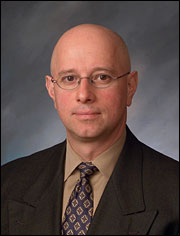Last week, World Energy Exchange, an online energy trading platform, officially launched a new marketplace for renewable-energy certificates and greenhouse-gas permits. The World Green Exchange employs an auction system — think eBay — to bring buyers and sellers together. In theory, auctions create a more transparent marketplace and drive out cost inefficiencies by directly connecting the buyer and seller and removing the middleman.

We caught up with World Energy President and COO Philip V. Adams last week to find out how the launch went and why he thinks WGE will stand out in an increasingly crowded field dominated by the Chicago Climate Exchange in the U.S. and European Climate Exchange and European Energy Exchange overseas.
Grist: Congratulations on launching the World Green Exchange. I know it’s only been up and running for a couple of days, but is it attracting users and working as you had hoped so far? How will you measure success longer term?
Adams: Thank you. The World Green Exchange was formally launched last week, but in fact we have been conducting transactions on the platform for the past several months. We’re a bit of a conservative firm, and took the view that we would have real client success in the marketplace before making an announcement of our capabilities. As we suspected, the auction approach is performing very well. In several transactions conducted to date, we have significantly bettered benchmark prices that were derived to our clients who were using brokers or bid-ask exchanges.
Grist: WGE is employing an auction-based trading system to match buyers and sellers. In layman’s terms, could you describe the benefits of WGE’s auction platform and how it functions?
Adams: Today’s environmental commodities markets are not very liquid nor very transparent, and our auction process creates more liquidity and more competition than other price-discovery mechanisms. There are three keys to our success. The first is creating an information-rich RFP (request for proposal) that answers all bidders’ potential questions, enabling them to evaluate the commodity and develop a bidding strategy. The second is recruiting as many potential bidders as possible. The third is creating a hypercompetitive environment whereby bidders are inspired to deliver their best price.
The Verdant auction in Alberta is an excellent example of all three of these aspects coming together. We provided a comprehensive RFP that answered all questions and created a compelling value proposition to potential bidders. We canvassed nearly 30 potential buyers and alerted them to the opportunity. Typically consultants work with two or three potential buyers because of diminishing returns in terms of incremental pricing improvement for the effort of sourcing several buyers. With eight committed bidders, we ran an auction event that yielded pricing 10+ percent higher than the company’s benchmark.
And here’s the secret sauce to our formula: we ran five different auctions to award the credits. The automated nature of the World Green Exchange auction software enabled us to test pricing for 80,000 tonnes of credits, 40,000, 20,000, 10,000, then 5,000. Once the prices were in, we closed the auction by awarding the top three bids for the 20,000 lot and the top two bids for the 10,000 lot. On a weighted average basis, this combination yielded the most revenue for the client.
Grist: There are no shortage of exchanges for trading emission credits. What makes you confident that WGE will be able to successfully compete against the more-established operations?
Adams: As we are finding in retail and wholesale energy with our World Energy Exchange auction platform, we believe that there is a significant market segment that will find the World Green Exchange auction as a superior pricing engine to bid-ask exchanges (our VER [voluntary emissions reduction] auction beat a bid-ask benchmark) and brokers (our Alberta auction bested a broker’s pricing). We are finding that auctions are beating bid-ask in North America’s most liquid natural gas trading point, and many economists tout auctions as a superior price-discovery method. We feel that our value proposition is unique and differentiated compared with the plethora of bid-ask exchanges in the market.
Grist: Currently, companies and individuals participating on the exchanges are doing so largely on a voluntary basis. Do you think a market-based trading approach will ever be fully recognized in the absence of a U.S.-sanctioned permitting process for carbon emissions?

Adams: Well, clearly this is the case in the U.S., as that market today is voluntary for most companies and individuals. Sites like AtmosClear are doing a wonderful job bringing awareness to the public, and offering a tangible way to fight global warming.
What we are also seeing, however, is that in the absence of a U.S.-sanctioned program, there are many state and local initiatives. Something like 28 states (it keeps growing!) have renewable portfolio standards whereby the utilities are mandated to have a certain percentage of their power generated from renewable sources.
We are seeing regional initiatives like the Northeast’s Regional Greenhouse Gas Initiative (RGGI) where a cap-and-trade system is being implemented starting in 2009. The West and Midwest are also contemplating programs, and of course the three presidential frontrunners are all proposing some form of cap-and-trade.
So while we haven’t ratified Kyoto, things are moving very rapidly toward mandated programs, and I wouldn’t be surprised if the voluntary market was dwarfed by mandated initiatives in the very near future.
Grist: What do you say to the people who view climate change strictly as a moral issue and complain that cap-and-trade solutions essentially allow wealthy nations and companies to shrug off their responsibility and continue to pollute at the expense of poorer countries?
Adams: That’s a good question, and I disagree with the premise. The Kyoto mechanisms are in place to channel funds to developing countries. Harkening back to my economics days in college, I believe the term is externality, and the Kyoto accord is essentially causing the polluters to pay for polluting. If a "wealthy nation" doesn’t have the assets or wherewithal to take advantage of green power opportunities (few rivers, low wind), Kyoto has aligned incentives that enable that country to invest in renewable power projects (hydro or wind) or carbon-remediation projects in countries that have those assets. This appears to be an economically appropriate solution.
I believe that the "shrugging" is a factor for countries that have opted out of cap-and-trade solutions, but as I said earlier, I believe that the U.S. will be a player in the cap-and-trade world whether that’s with its own version or signing on to Kyoto.
Grist: A market-driven exchange solution has the unique distinction of being favored by both Democrats and Republicans, but there is growing support for a carbon tax — which its proponents claim is more equitable. Is it possible — indeed necessary — for an exchange, carbon tax, and other legislated solutions to live side by side to effectively reduce carbon emissions?
Adams: It seems to me that there should be one model in place, and given how well cap-and-trade has done with acid rain over the last couple of decades, and since it’s been adopted for Kyoto, I’m willing to believe that cap-and-trade is here to stay.
Grist: Do you have back-of-the-envelope estimate on the size of the U.S. emission credit market?
Adams: To be honest with you, there are other organizations whose sole mission in life is market sizing, so I’d be doing you a disservice to give my estimate. Suffice to say that it’s large enough to get our attention and for us to make investments — such as the launch of the World Green Exchange — to make it an important part of our strategic plan.



